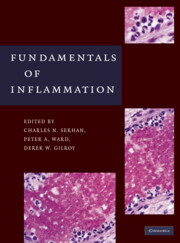Book contents
- Frontmatter
- Contents
- Contributors
- Preface
- PART I THE INFLAMMATORY RESPONSE – AN OVERVIEW
- PART II INDIVIDUAL CELL TYPES
- PART III CHEMICAL MEDIATORS
- PART IV IMMUNOPHARMACOLOGY
- PART V INFLAMMATORY DISEASES/HISTOLOGY
- 20 Lung
- 21 Neural Inflammation, Alzheimer's Disease, and Stroke
- 22 Rheumatoid Arthritis/SLE
- 23 Gastrointestinal Inflammation and Ulceration: Mediators of Induction and Resolution
- 24 Inflammatory Skin Diseases
- 25 Kidney Glomerulonephritis and Renal Ischemia
- 26 Inflammation in Cardiovascular Diseases
- PART VI ANIMAL MODELS OF INFLAMMATION
- Index
- References
26 - Inflammation in Cardiovascular Diseases
from PART V - INFLAMMATORY DISEASES/HISTOLOGY
Published online by Cambridge University Press: 05 April 2014
- Frontmatter
- Contents
- Contributors
- Preface
- PART I THE INFLAMMATORY RESPONSE – AN OVERVIEW
- PART II INDIVIDUAL CELL TYPES
- PART III CHEMICAL MEDIATORS
- PART IV IMMUNOPHARMACOLOGY
- PART V INFLAMMATORY DISEASES/HISTOLOGY
- 20 Lung
- 21 Neural Inflammation, Alzheimer's Disease, and Stroke
- 22 Rheumatoid Arthritis/SLE
- 23 Gastrointestinal Inflammation and Ulceration: Mediators of Induction and Resolution
- 24 Inflammatory Skin Diseases
- 25 Kidney Glomerulonephritis and Renal Ischemia
- 26 Inflammation in Cardiovascular Diseases
- PART VI ANIMAL MODELS OF INFLAMMATION
- Index
- References
Summary
INTRODUCTION
Inflammation has emerged as a key pathophysiological event in vascular diseases and the consequent cardiac and cerebral ischemic injury. There is ample evidence that inflammation is intimately involved in atherosclerosis. It mediates the initiation of atherosclerosis, promotes progression of the atherosclerotic lesions, and regulates atheromatous plaque stability [1, 2]. There is also good evidence that inflammation plays a crucial role in ischemia-reperfusion cardiac and cerebral injury [3, 4].
Inflammation is a complex process involving multiple cellular and molecular components. It is triggered by diverse proinflammatory mediators (PIM) which are generated directly and indirectly by microbial invasion, endotoxins, immune complexes, and cytokines. Vascular endothelium is subjected to pro inflammatory insults, as it is in constant contact with circulating blood and along with it many environmental stressful factors. Fortunately, endothelium is endowed with potent anti-inflammatory molecules that confer resistance to damage by transient proinflammatory attacks. Once the insulting factors dissipate, endothelial cells return to its basal state. The mechanisms by which endothelial cells resist insults are likely to be very complex. One model is stress-coupled induction of anti-inflammatory and cytoprotective genes [5]. This mechanism allows for timely defense against transient insults. However, when insults by PIMs become persistent, this protective property wears out resulting in endothelial cell damage and functional defects and eventually endothelial apoptosis and necrosis.
- Type
- Chapter
- Information
- Fundamentals of Inflammation , pp. 317 - 328Publisher: Cambridge University PressPrint publication year: 2010

